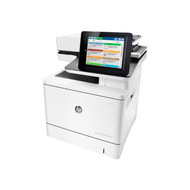How Laser Technology Works
Posted by BK on 1st Jun 2021
Laser printers have been helping businesses produce documents since 1969. They’re generally considered the fastest choice. Monochrome laser printers are well known for producing outstanding text with crisp black details. In recent years, color laser printers have hit the market, opening the door to color printing — but at a high cost as individual color toner cartridges tend to be expensive.
When shopping for a new printer or comparing laser versus inkjet printers, it’s helpful to understand how the underlying technology works.
Laser printers have a long list of parts that work together to print a document. Here’s how it works:
- You send a document to the printer from your computer.
- The laser printer starts warming up. This process can take a while, and is energy intensive.
- A coated metal cylinder called a drum begins to rotate, receiving a positive static charge from the heated corona wire. If you have a color laser printer, there will be four drums doing this (one for each black and color toner cartridge).
- Next, the laser turns on and beams the image across a series of mirrors, which reflect the document image onto the drum or drums and produce a negative charge.
- Because the drums are statically charged, the area affected by the laser’s negative charge attracts dry toner particles from the toner cartridges. The area of the drum that did not receive the laser’s negative charge remains positively charged, and therefore, no toner attaches to that portion of the drum.
- The paper rolls through a transfer belt, receiving a positive charge. When the paper comes in contact with the drum, the negatively charged toner is then attracted to the positively charged paper.
- The paper then passes through a heated fuser roller unit, which melts (or fuses) the toner to the paper.
- A wiper blade removes any excess toner from the drum and any latent image from the printer is erased from the drum.
- The printed page emerges from the laser printer.
Toner Types
Toner is a dry powder contained in a toner cartridge. It is a consumable item as the laser printer will use toner to produce printed pages and photocopies. Once the toner cartridge runs out of toner, you will need to replace it with a new toner cartridge.
For monochrome laser printers, just one black toner cartridge is used. For color laser printers, four toner cartridges are required: black, cyan, magenta, and yellow. Specialty laser printers may also use specialty toners like white toner cartridges or security toner cartridges.
Toner cartridges are typically available as OEM toner cartridges (from the original equipment manufacturer), compatible toner cartridges from third parties, and remanufactured toner cartridges (which is a used toner cartridge that has been remanufactured and refilled with fresh toner). OEM toner cartridges are highly recommended over the other options.
Laser Printer Mechanical Parts
Laser printers are complex machines with a variety of moving parts required to print an image. These parts include:
- Power supply — Many laser printers use 220-volt electrical connections.
- Control circuitry — A variety of electronic components are included in laser printers. Some include large color display panels while others use navigation buttons.
- Laser — The laser transmits the image to be printed onto mirrors, which reflect the image onto the drum. Laser light is bright and precise.
- Drum Unit — The rotating drum receives the image. It features a special coating that can receive both positive and negative charges. Depending on the laser printer, the drum may be a standalone part or it may be included within the toner cartridge. Drums are replaceable parts.
- Toner cartridge — The toner cartridge contains the dry powder toner, typically made of carbon / iron oxide. Toner cartridges must be replaced once the toner is consumed.
- Paper tray, rollers, and motor — Paper is stored in a paper tray until printing begins. A motor pulls the paper along a series of rollers, moving it through the printer.
- Transfer belt (or rollers) — The transfer belt, or in some printers, a series of rollers, is used to move the paper through the printer so that the toner can be transferred and fused onto the page.
- Fuser unit — The fuser provides the finishing touches to the print job by melting the toner and fusing it onto the page, ensuring a durable, smudge-free printout.
- Interface ports — Printer ports such as parallel, serial, USB, wireless, fax, and Bluetooth ports provide connectivity to computers and mobile devices.
Energy Consumption
Since laser printers rely on heat to produce static charges and melt the toner, they tend to use a lot more energy than their inkjet-based counterparts. In fact, they must warm up to nearly 400 degrees Fahrenheit and most require 220-volt outlets.
Using standby mode and automatic shut-off features can help conserve energy, but there’s a lengthy warmup period before printing can begin.
Is a Laser Printer the Right Choice For Your Office?
The fact that laser quality text is considered the gold standard coupled with fast print speeds make laser printers an outstanding choice for many businesses. However, color laser printers are cost-prohibitive, and energy costs for either monochrome or color laser printers remain a concern. If you’re considering an office printer purchase, we’d urge you to look beyond laser technology to the latest generation of business inkjet printers from Epson. These are fast, affordable office machines that rival laser printers in every way.
DuraFast Label Company offers a free print cost analysis so you can discover just how affordable color printing can be. Request your free, no obligation print cost analysis now.
